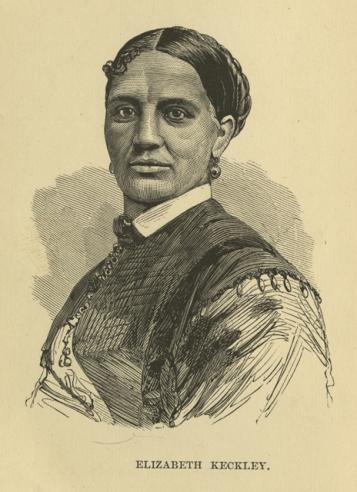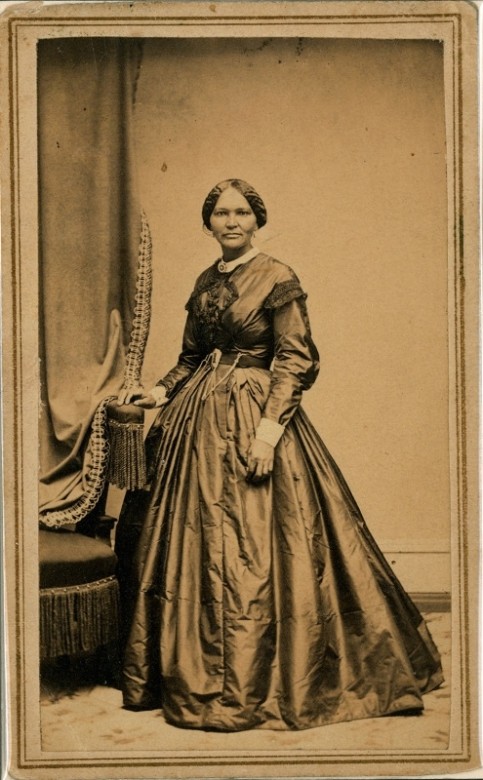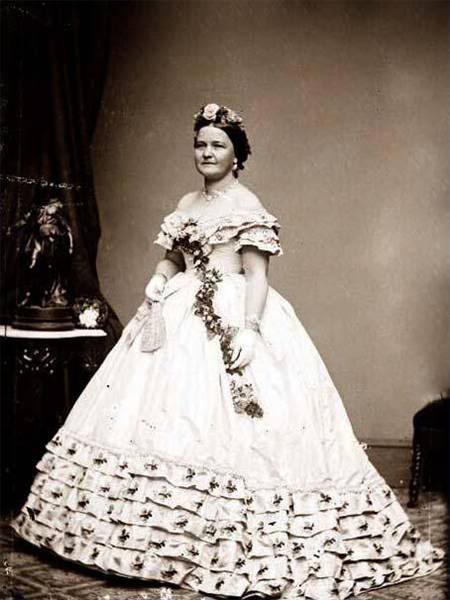|
From Slavery to the White House Elizabeth Keckley was born into slavery in Dinwiddie, Virginia in 1818. Her parents were listed as George and Agnes Hobbs. George Hobbs was a slave owned by a different master on a different farm. George was devoted to his wife and daughter, even though he knew that she was not his. Colonel Armistead Burwell, Agnes’s master, was Lizzy’s biological father. Whether the she was raped by her master, which was not an unusual thing, or consented, we will never know. It was not something a female slave shared with others. It was so common a custom that it was accepted as a rite of the master to possess his slaves in every manner.
Before leaving Dinwiddie, Armistead decided which slaves he would take with him and which slaves he would sell on the open market. As a college steward, he would need slaves to slaughter hogs, milk cows, garden, cook and serve food, haul wood, clean, do laundry, and look after his children. Once he settled his affairs, Armistead had to force his remaining slaves to move. This included Lizzy and her mother, but not her father George, who had to remain in Dinwiddie with his master. George was allowed to visit only twice a year, at Christmas and Easter, so Lizzy did not see much of her father. The year after they arrived at Hampden-Sydney, Armistead’s wife Mary gave birth to their last child, a daughter, Elizabeth Margaret. With four other children to look after under the age of ten, it was decided that Lizzy, who was five years old would look after the new baby. It was the family tradition to give the mulatto girls and women as gifts to their daughters and the Burwells promised Lizzy that if she rocked the cradle and kept the baby from crying she would be Elizabeth’s little maid. Even though she had to leave her mother’s cabin to move into the Burwell’s house, Lizzy was proud of her new position. Working in the main house often brought with it a better diet, better clothing and opportunities for personal improvement. Lizzy learned as much as she could and it was her mother who taught her to sew. Clothing was still made at home and in most instances the slaves would make the cloths from patterns provided by their mistress. A few years after coming to Hampden-Sydney, Armistead tried to make a deal to have Lizzy’s father come live with them at the college. The deal fell through and George’s master decided to move to Tennessee and take George with him. Lizzy and her mother were heart-broken. Lizzy was only seven years old. Being Armistead’s daughter may have saved her from the auction block, since a man who sold his own flesh and blood into slavery was not highly regarded. No one respected a man who sold his child, but it was a generous master who lent his slave to a friend or relative who needed help but could not afford to purchase it. In 1832 at the age of 14 Lizzy was loaned to Armistead’s oldest son, Robert, and his new bride, Anna. Robert was an ordained Presbyterian minister. Robert and Anna took Lizzy with them to Chesterfield County, Virginia where they stayed three years. During this time Anna gave birth to two children. Lizzy was their only slave and her workload was enormous. Their next move was to Hillsborough, North Carolina where Robert became the minister at the Presbyterian Church. Orange County was a prosperous, slave holding territory. 33 percent of the county’s population were slaves and about 3 percent were free blacks. Lizzy would become accustomed to seeing slaves with more mobility than she was used to. She was also more likely to encounter more free black Americans than she had before. Anna Burwell started a school in Hillsborough to help supplement Robert’s $400 a year salary. Anna advertised her school’s four-year course as one that would teach your ladies to think, and make them scholars and useful members of society. Terms began in August and January. One of the few female academies in North Carolina, Mrs. Burwell’s school was a source of community pride. Since Anna was tied up with her school duties the household chores and child sitting duties were left almost entirely for Lizzy. Her days were filled with looking after the children, sewing, cleaning and washing and ironing. While in Hillsborough Lizzy was repeatedly abused by Alexander Kirkland, the son of Margaret Scott and William Kirkland, one of Hillsborough’s most successful merchant-planters. Kirkland was a large man and a heavy drinker. Lizzy endured his abuse for over 4 years. Lizzy became pregnant and gave birth to a son in 1839, who she named after her father, George Her life improved when she was loaned to a Burwell daughter, Anne Garland, who lived in St. Louis. There, her labor as a dressmaker was the sole support of the Garland household of seventeen members for more than two years. Because of her skill, engaging personality, and capacity for hard work, she developed a devoted clientele among the city's elite women. She persuaded the Garlands to set a price, $1,200, for her freedom and that of her son. In 1852 in St. Louis she married James Keckley, a man who had told her he was free but was actually a dissolute, alcoholic slave. Because of the strain of supporting both her husband and the Garlands, she could not save the money needed to purchase her freedom. Her customers raised it among themselves and the Deed of Emancipation was registered in 1855. After paying back her clients, Keckley left her husband and took her son to Washington, D.C., where in the spring of 1860 she opened a dressmaking shop.
Over the years, Keckley and Mary Todd Lincoln became close. Keckley was often called to the White House to dress the first lady, where she witnessed intimate moments between the President and his wife, received the confidences of Mrs. Lincoln, and observed the domestic interactions of the first family. Keckley was also present during many of Mrs. Lincoln's discussions with her husband, during which the latter offered opinions about members of his cabinet or his political affairs. Keckley and Mrs. Lincoln also bonded over the loss of their sons. Keckley appreciated Mrs. Lincoln's consoling letter after her son George was killed at the battle of Wilson's Creek, Missouri, in August 1861, and Mrs. Lincoln relied heavily on Keckley during her grief after young Willie Lincoln died of typhoid fever. As the Civil War continued, black refugees, called contrabands, poured out of the South into the capital, where they lived in wretched conditions in makeshift camps. Keckley, who attended the Fifteenth Street Presbyterian Church, as did most of the other White House servants, organized forty women from that church into the Contraband Relief Association in August 1862. They raised money by sponsoring concerts and a festival, collected clothes that they repaired, and solicited donations of money, food, and blankets for the contrabands. In the fall, Keckley accompanied Mary Lincoln to New York City and Boston, where she took the opportunity to obtain donations from northern benevolent societies. Records show that "Mrs. President Lincoln" donated $200 and fifty comforters. The following year, Keckley and her associates changed the name of the association to the Freedmen and Soldiers' Relief Fund and received help from Frederick Douglass, who personally solicited contributions from antislavery societies in England and Scotland.
In the spring of 1867 she began to receive letters from Mary Lincoln, who wrote that she was impoverished and planned to sell her clothes and jewelry to raise money. After she begged Keckley to join her in New York City to help with the sale, Keckley closed her business and went. Newspapers had a field day with the "old clothes scandal," heaping severe criticism on the president's widow for trying to supplement her income in what was considered a vulgar manner. The clothes did not sell, however, and Mary Lincoln returned to Chicago. Keckley stayed in New York City to wind up affairs. She raised money within the black community to aid her former employer, but Mary Lincoln refused it. In 1868 Keckley published her autobiography, Behind the Scenes; or, Thirty Years a Slave, and Four Years in the White House, which she said she wrote to help Mary Lincoln financially as well as to counter what she considered unjust criticisms. Though Keckley anticipated some disapproval for publishing personal details about Mrs. Lincoln and White House private life, she did not foresee the overwhelming public disapproval that led to the end of her dressmaking career as well as strong disapproval from the Lincoln family. When she ran out of money she accepted a faculty position at Ohio's Wilberforce University in the Department of Sewing and Domestic Science Arts in 1892. Ill health following a stroke forced her resignation after only a year. She spent some time in Philadelphia before returning to Washington, D.C. Little is known of her final years. At the end of her life, she lived in a small basement room in the home maintained by the National Association for Destitute Colored Women and Children, a Washington, D.C. institution directly descended from the Contraband Relief Association she had founded. She died there after a stroke in 1907. Keckley was a proud, distinguished lady and was considered beautiful in her day. Her story has been revived and explored in plays and books such as Mrs. Lincoln's Dressmaker, written by Jennifer Chiaverini and published in 2013. |
 It
was a constant struggle for Lizzy’s master, Armistead Burwell, to make
ends meet. Times were hard and after the bank panic in 1819, he was
forced to sell his property. In 1822 he took a job as steward at
Hampden-Sydney College, in Prince Edward County, seventy miles southwest
of Richmond, Virginia. Armistead sold his livestock, packed up his
household and moved west to make a fresh start.
It
was a constant struggle for Lizzy’s master, Armistead Burwell, to make
ends meet. Times were hard and after the bank panic in 1819, he was
forced to sell his property. In 1822 he took a job as steward at
Hampden-Sydney College, in Prince Edward County, seventy miles southwest
of Richmond, Virginia. Armistead sold his livestock, packed up his
household and moved west to make a fresh start. Keckley's
clients were the wives of politically prominent men, such as Stephen
Douglas and Jefferson Davis. In exchange for making a dress in an
extremely short time, one of her customers recommended her to Mary Todd
Lincoln, wife of the newly elected president, Abraham Lincoln. On March
3, 1861 a remarkable relationship began when Mary Lincoln hired Keckley
as her dressmaker. Keckley was a woman of great presence and
intelligence, tall, with twinkling eyes, a radiant smile, light skin,
straight black hair, and impeccable manners. Mary Lincoln not only liked
the dresses designed to show off her neck and arms but also found
Keckley an entertaining companion and soothing influence. Keckley was
soon a confidante of the family, and her duties extended far beyond
dressmaking.
Keckley's
clients were the wives of politically prominent men, such as Stephen
Douglas and Jefferson Davis. In exchange for making a dress in an
extremely short time, one of her customers recommended her to Mary Todd
Lincoln, wife of the newly elected president, Abraham Lincoln. On March
3, 1861 a remarkable relationship began when Mary Lincoln hired Keckley
as her dressmaker. Keckley was a woman of great presence and
intelligence, tall, with twinkling eyes, a radiant smile, light skin,
straight black hair, and impeccable manners. Mary Lincoln not only liked
the dresses designed to show off her neck and arms but also found
Keckley an entertaining companion and soothing influence. Keckley was
soon a confidante of the family, and her duties extended far beyond
dressmaking. As
Mary Lincoln's dresser, Keckley prepared her for every public occasion;
as her confidante, she shared her anxieties; as her traveling companion,
she went to the Gettysburg dedication and toured Richmond after the city
fell. Keckley was the first person Mary Lincoln asked for after the
President’s assassination. When Mary Lincoln left the White House in
1865, Keckley accompanied her to Chicago. After seeing the family
settled, she returned to Washington, D.C., where she reopened her
dressmaking business.
As
Mary Lincoln's dresser, Keckley prepared her for every public occasion;
as her confidante, she shared her anxieties; as her traveling companion,
she went to the Gettysburg dedication and toured Richmond after the city
fell. Keckley was the first person Mary Lincoln asked for after the
President’s assassination. When Mary Lincoln left the White House in
1865, Keckley accompanied her to Chicago. After seeing the family
settled, she returned to Washington, D.C., where she reopened her
dressmaking business.